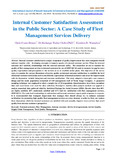| dc.contributor.author | Oteki, Evans B. | |
| dc.contributor.author | Bichanga, W. O. | |
| dc.contributor.author | Wamalwa, R. W. | |
| dc.date.accessioned | 2021-05-17T12:29:02Z | |
| dc.date.available | 2021-05-17T12:29:02Z | |
| dc.date.issued | 2014-09 | |
| dc.identifier.citation | International Journal of Recent Research in Commerce Economics and Management (IJRRCEM) Vol. 1, Issue 2, pp: (12-28), Month: July 2014 - September 2014, Available at: www.paperpublications.org | en_US |
| dc.identifier.issn | 2349-7807 | |
| dc.identifier.uri | https://www.semanticscholar.org/paper/Internal-Customer-Satisfaction-Assessment-in-the-A-Biraori-Wamalwa/3ca7bab770fd9044f772b10abcd233acded90e83 | |
| dc.identifier.uri | https://www.paperpublications.org/upload/book/Internal%20Customer%20Satisfaction%20Assessment-71.pdf | |
| dc.identifier.uri | http://hdl.handle.net/123456789/4672 | |
| dc.description.abstract | Internal customer satisfaction is a major component of quality improvement that most companies should embrace together with developing strategies to improve quality of external customer service. When the internal customer isn't satisfied, relationships with the external customer suffer. The researcher set out to examine the quality of fleet management services to internal customers by use of SERVQUAL scale to measure the gap between quality expectations and perceptions of the services so as to establish action plans. The objectives of the survey were, to examine the various dimensions of service quality on internal customer satisfaction, to establish the level of internal customer satisfaction and to establish the expectations of internal customers and areas for improvement with the dependent variable being internal customer satisfaction. The study adopted a descriptive case research design and the study population comprised of 118 management staff of Nzoia Suagr Company. A purposive sampling technique was employed to select a sample size of 34 respondents. Questionnaires, interviews, secondary data and observation were used for data collection. Descriptive statistics data analysis method was applied to analyze numerical data gathered aided by Statistical Package for Social Sciences (SPSS). Results show that 48% are highly satisfied, 40% moderately satisfied and 12% had low satisfaction with fleet management services, SERVQUAL five scale had relationships to satisfaction and internal customers expect quick responses to requests. It is recommended that transport department that manages fleet should always try to enhance customer satisfaction via presenting high quality fleet management services, as a key element, in order to, first, not weaken those dimensions which the internal customers are satisfied with and secondly, improve those services that aren't quality from internal customers perspective. | en_US |
| dc.language.iso | en | en_US |
| dc.subject | External customer, Fleet Management, Internal customer, Service level agreements, Service Quality, Supply Chain Management, Total Quality Management. | en_US |
| dc.title | Internal Customer Satisfaction Assessment in the Public sector: A case study of Fleet management services delivery. | en_US |
| dc.type | Article | en_US |

